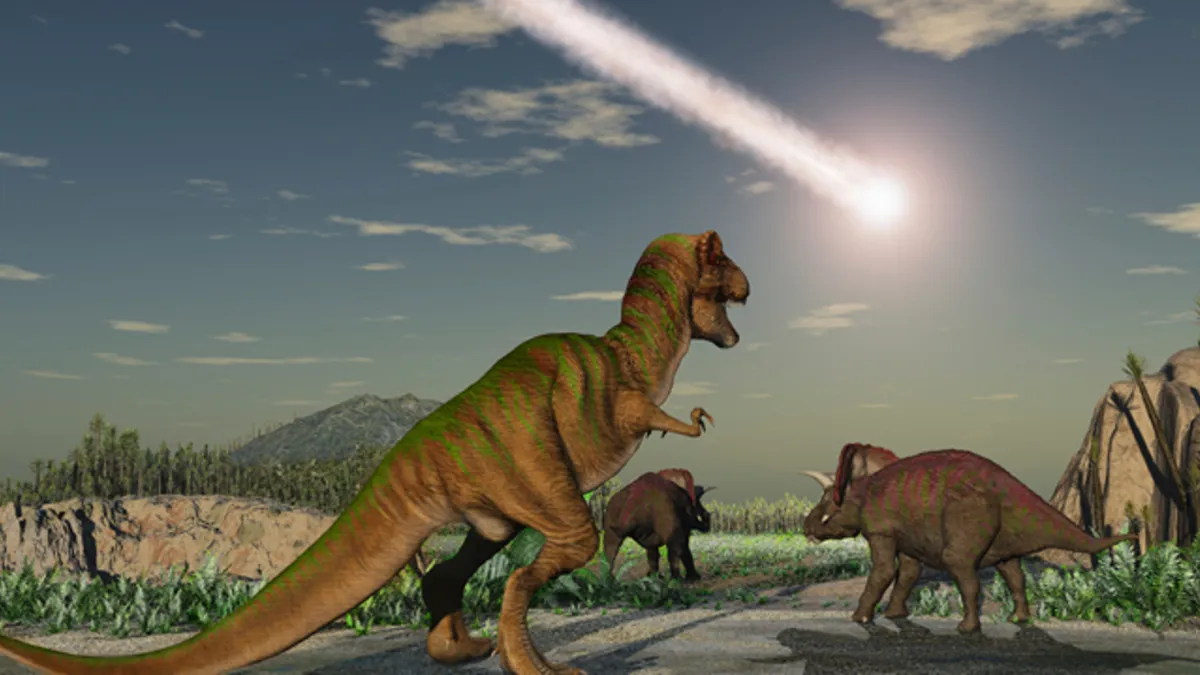When I studied university science, we were given a checklist of “How to spot a pseudo-science.” What’s passed off by the media-political elite as ‘climate science’ ticked nearly every box, from Resisting Change and Professing Certainty, to Making Exaggerated Claims and Claiming a Conspiracy Against Them. The same lecturer also praised scepticism in science – and in the very next breath, added, “But if you question climate science, you’re just a denialist.”
Real science, unlike popular ‘climate science’, is never ‘settled’. In fact, the harder the science, the less settled it is. Physicists will argue over measurements made to the sixth decimal point.
And, despite the decades of steadily accumulating evidence, paleontologists stubbornly disputed the asteroid theory of dinosaur extinction. More recent discoveries, though, are making it near-impossible to dispute. The discoveries, in the 1970s and ’80s of, first the iridium-rich layer of burned, shocked sediments that spans the globe from 65 million years ago, to the gargantuan Chicxulub crater beneath the Gulf of Mexico, seemed pretty conclusive. “It ain’t necessarily so,” sang the paleontological dissenters.
One competing argument was that dinosaurs had been in long-term decline, to the brink of dying out, even before the Chicxulub asteroid.
One of the central mysteries of paleontology is the so-called “three-metre problem.” In a century and a half of assiduous searching, almost no dinosaur remains have been found in the layers three metres, or about nine feet, below the KT boundary, a depth representing many thousands of years. Consequently, numerous paleontologists have argued that the dinosaurs were on the way to extinction long before the asteroid struck, owing perhaps to the volcanic eruptions and climate change. Other scientists have countered that the three-metre problem merely reflects how hard it is to find fossils. Sooner or later, they’ve contended, a scientist will discover dinosaurs much closer to the moment of destruction.
The Hell Creek geological formation of North and South Dakota, Montana and Wyoming, has been a famous source of dinosaur fossils since the late 19th century. In the past decade, though, it’s yielded new discoveries that indicate teeming dinosaur life apparently up to the very instant of the impact. It also contains undeniable evidence of a vast catastrophe.
At the time of the impact, the Hell Creek landscape consisted of steamy, subtropical lowlands and floodplains along the shores of an inland sea. The land teemed with life and the conditions were excellent for fossilization, with seasonal floods and meandering rivers that rapidly buried dead animals and plants […] One paleontologist estimated that in the Cretaceous period Hell Creek was so thick with T. rexes that they were like hyenas on the Serengeti. It was also home to triceratops and duckbills.
The Hell Creek Formation spans the Cretaceous and the Paleogene periods – in other words, before and after the asteroid impact. About a decade ago, paleontologist Robert DePalma began excavating a small site in the Hell Creek Formation. One thing he soon noticed was that the sediments contained unusual grayish-white specks, like grains of sand. In fact, they turned out to be microtektites: the blobs of glass that form when molten rock is blasted into the air by an asteroid impact.
The site appeared to contain microtektites by the million.
As DePalma carefully excavated the upper layers, he began uncovering an extraordinary array of fossils, exceedingly delicate but marvellously well preserved. “There’s amazing plant material in there, all interlaced and interlocked,” he recalled. “There are logjams of wood, fish pressed against cypress-tree root bundles, tree trunks smeared with amber.” Most fossils end up being squashed flat by the pressure of the overlying stone, but here everything was three-dimensional, including the fish, having been encased in sediment all at once, which acted as a support. “You see skin, you see dorsal fins literally sticking straight up in the sediments, species new to science,” he said. As he dug, the momentousness of what he had come across slowly dawned on him. If the site was what he hoped, he had made the most important paleontological discovery of the new century.
For one thing, DePalma’s discovery of hadrosaur vertebrae fused around an embedded tyrannosaur tooth – meaning that it had been bitten by a tyrannosaur but escaped – put paid to the then-dominant theory that T rex was solely a scavenger.
But it was the discovery of marine species washed up what was even then miles inland, tektites embedded in what was originally soft river mud and other signs of a stupendous catastrophe that revealed how important the site was.
“When I saw that, I knew this wasn’t just any flood deposit,” DePalma said. “We weren’t just near the KT boundary – this whole site is the KT boundary!” From surveying and mapping the layers, DePalma hypothesized that a massive inland surge of water flooded a river valley and filled the low-lying area where we now stood, perhaps as a result of the KT-impact tsunami, which had roared across the proto-Gulf and up the Western Interior Seaway. As the water slowed and became slack, it deposited everything that had been caught up in its travels – the heaviest material first, up to whatever was floating on the surface. All of it was quickly entombed and preserved in the muck: dying and dead creatures, both marine and freshwater; plants, seeds, tree trunks, roots, cones, pine needles, flowers, and pollen; shells, bones, teeth, and eggs; tektites, shocked minerals, tiny diamonds, iridium-laden dust, ash, charcoal, and amber-smeared wood. As the sediments settled, blobs of glass rained into the mud, the largest first, then finer and finer bits, until grains sifted down like snow […]
The deposit consisted of dozens of thin layers of mud and sand. Lower down, it graded into a more turbulent band of sand and gravel, which contained the heavier fish fossils, bones, and bigger tektites. Below that layer was a hard surface of sandstone, the original Cretaceous bedrock of the site, much of which had been scoured smooth by the flood […]
“We have the whole KT event preserved in these sediments,” DePalma said. “With this deposit, we can chart what happened the day the Cretaceous died.” No paleontological site remotely like it had ever been found, and, if DePalma’s hypothesis proves correct, the scientific value of the site will be immense.
Other fossils include feathers, fish buried upright in the sediment and un-scavenged, because even the scavengers were dead. Trees buried alive, with their leaves and needles still on the branches.
Gradually, DePalma was piecing together a potential picture of the disaster. By the time the site flooded, the surrounding forest was already on fire, given the abundance of charcoal, charred wood, and amber he’d found at the site. The water arrived not as a curling wave but as a powerful, roiling rise, packed with disoriented fish and plant and animal debris, which, DePalma hypothesized, were laid down as the water slowed and receded […]
In the lab, DePalma showed me magnified cross-sections of the sediment. Most of its layers were horizontal, but a few formed curlicues or flamelike patterns called truncated flame structures, which were caused by a combination of weight from above and mini-surges in the incoming water. DePalma found five sets of these patterns. He turned back to the block on his table and held a magnifying lens up to the tektite. Parallel, streaming lines were visible on its surface – Schlieren lines, formed by two types of molten glass swirling together as the blobs arced through the atmosphere […]
DePalma listed some of the other discoveries he’s made at the site: several flooded ant nests, with drowned ants still inside and some chambers packed with microtektites; a possible wasp burrow; another mammal burrow, with multiple tunnels and galleries; shark teeth; the thigh bone of a large sea turtle; at least three new fish species; a gigantic ginkgo leaf and a plant that was a relative of the banana; more than a dozen new species of animals and plants; and several other burrow types.
At the bottom of the deposit, in a mixture of heavy gravel and tektites, DePalma identified the broken teeth and bones, including hatchling remains, of almost every dinosaur group known from Hell Creek, as well as pterosaur remains, which had previously been found only in layers far below the KT boundary. He found, intact, an unhatched egg containing an embryo – a fossil of immense research value. The egg and the other remains suggested that dinosaurs and major reptiles were probably not staggering into extinction on that fateful day. In one fell swoop, DePalma may have solved the three-metre problem and filled in the gap in the fossil record.
The New Yorker
More recent analysis and computer modelling suggests that DePalma’s site records a precise geological transcript of the first hour or so after the impact.
Yet, still the arguments continue. “I’m suspicious of the findings,” says one prominent paleontologist.
“It’s like finding the Holy Grail clutched in the bony fingers of Jimmy Hoffa, sitting on top of the Lost Ark,” DePalma shoots back.
Don’t ever let anyone tell you ‘the science is settled’.








